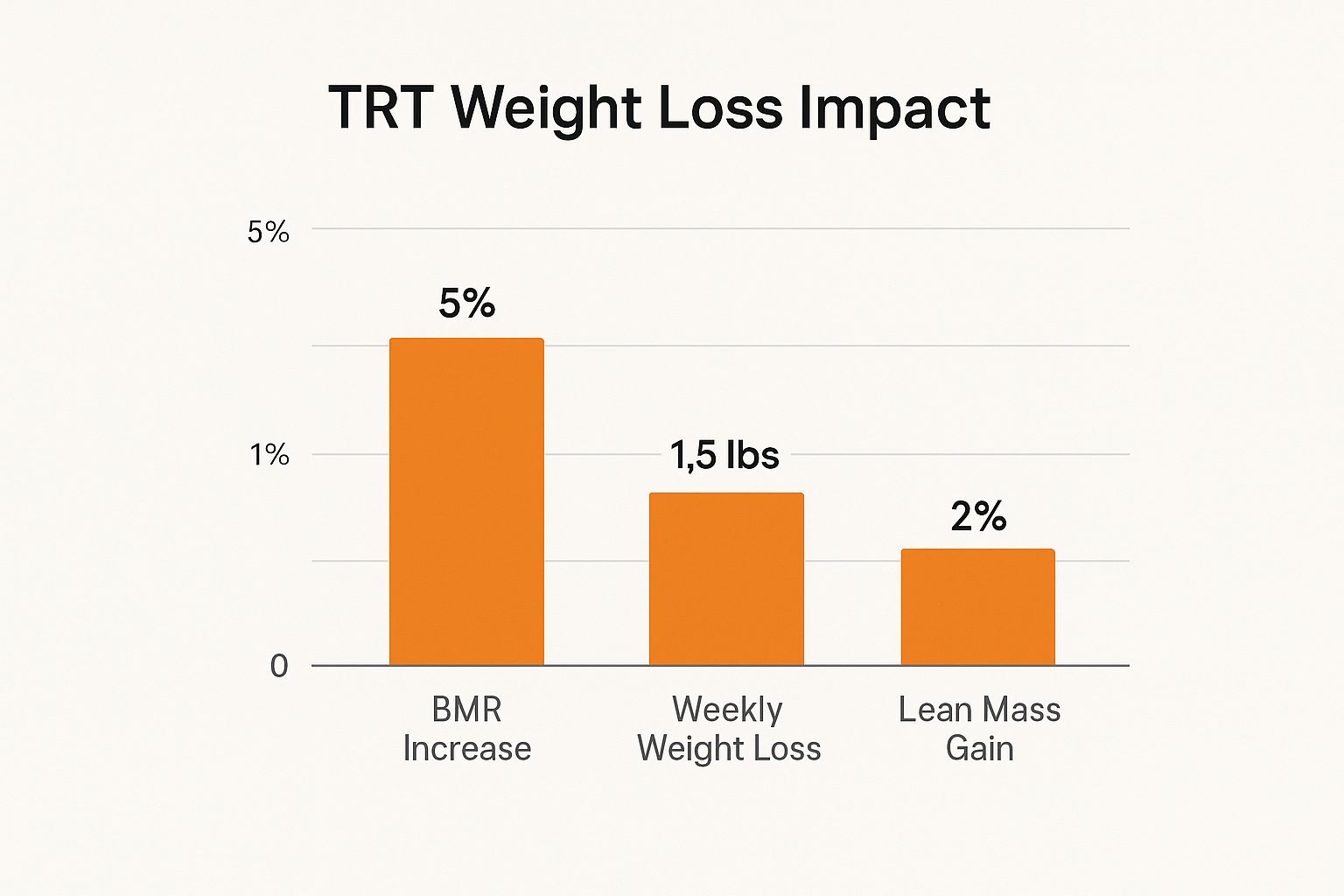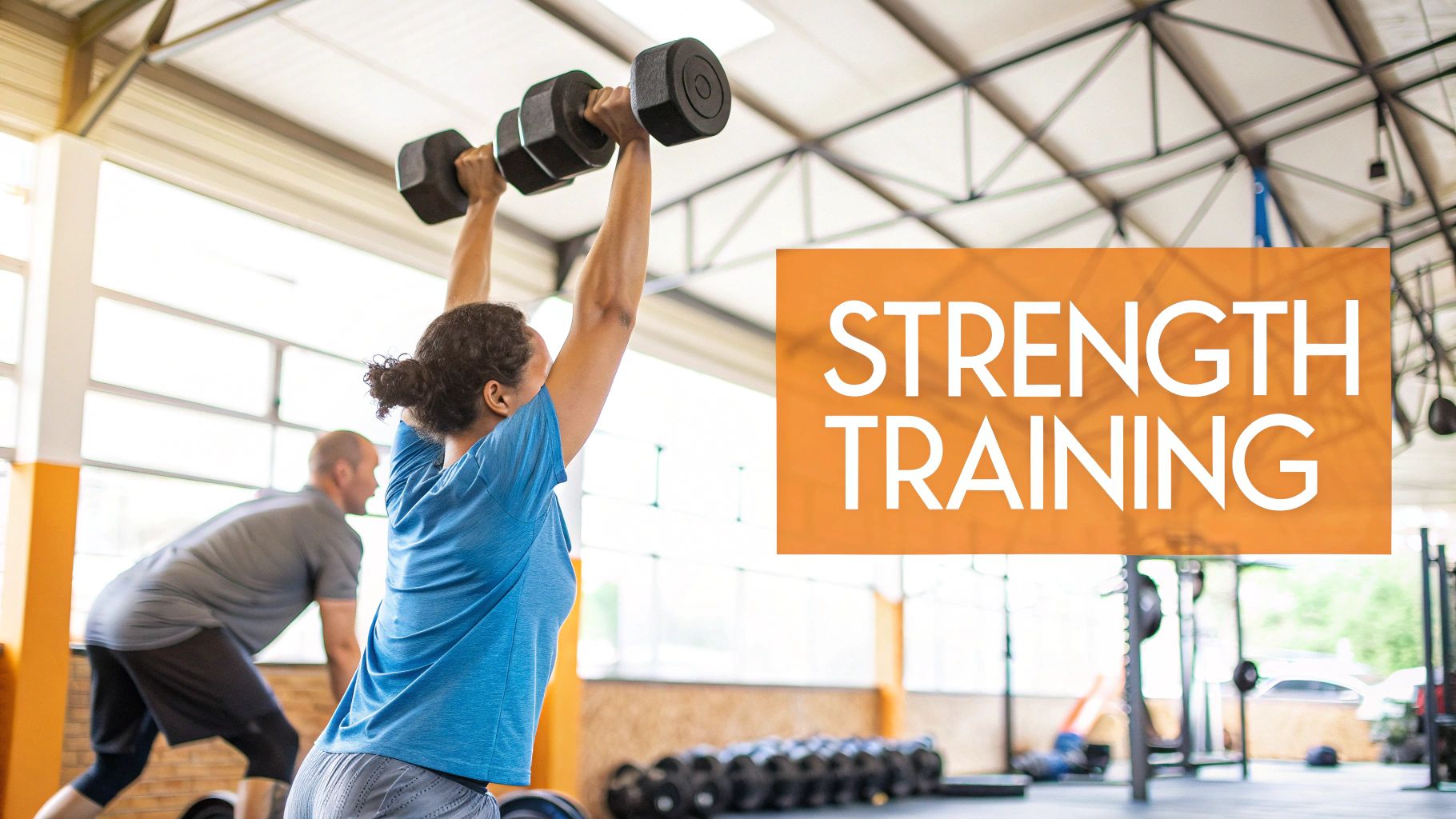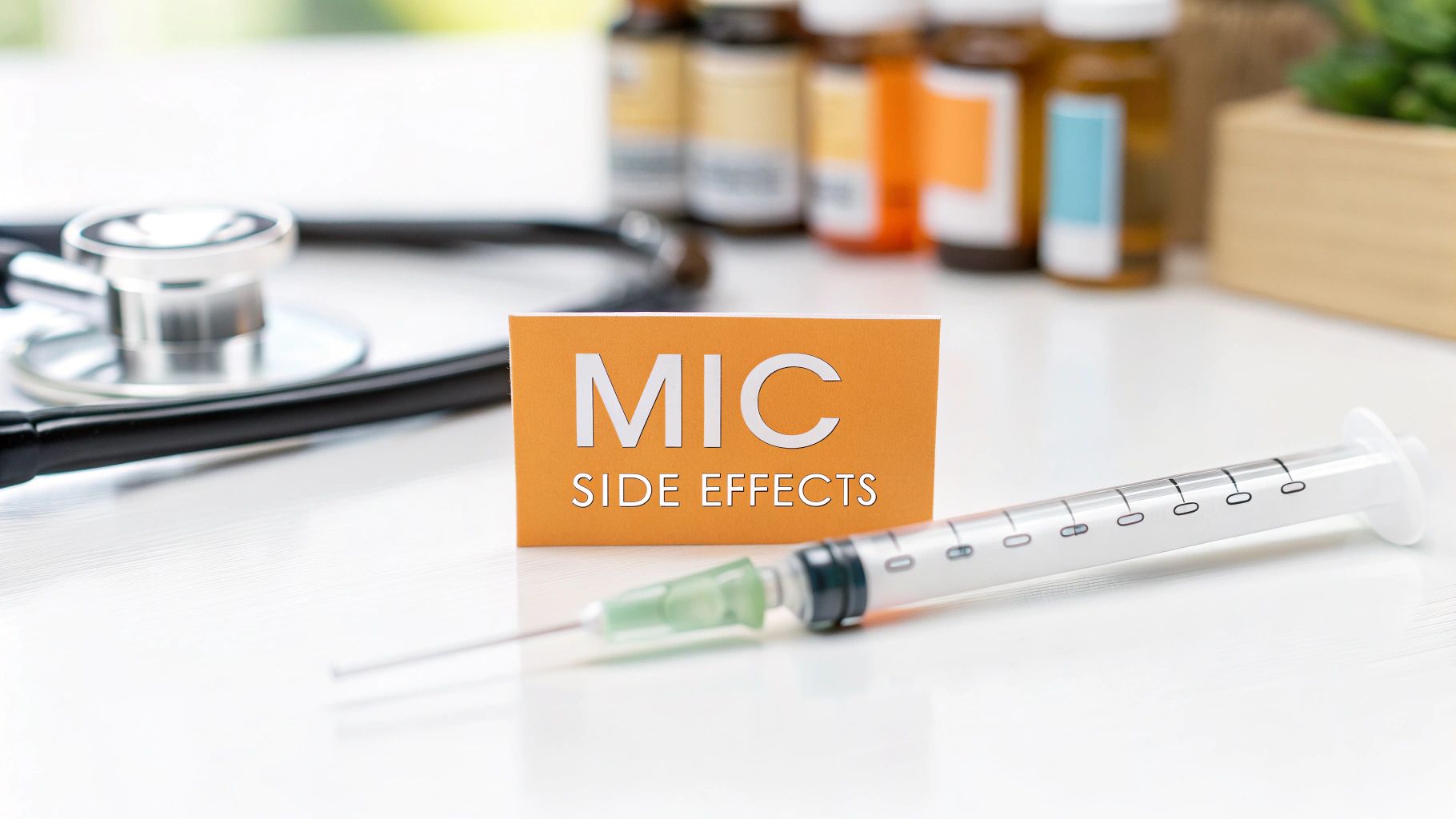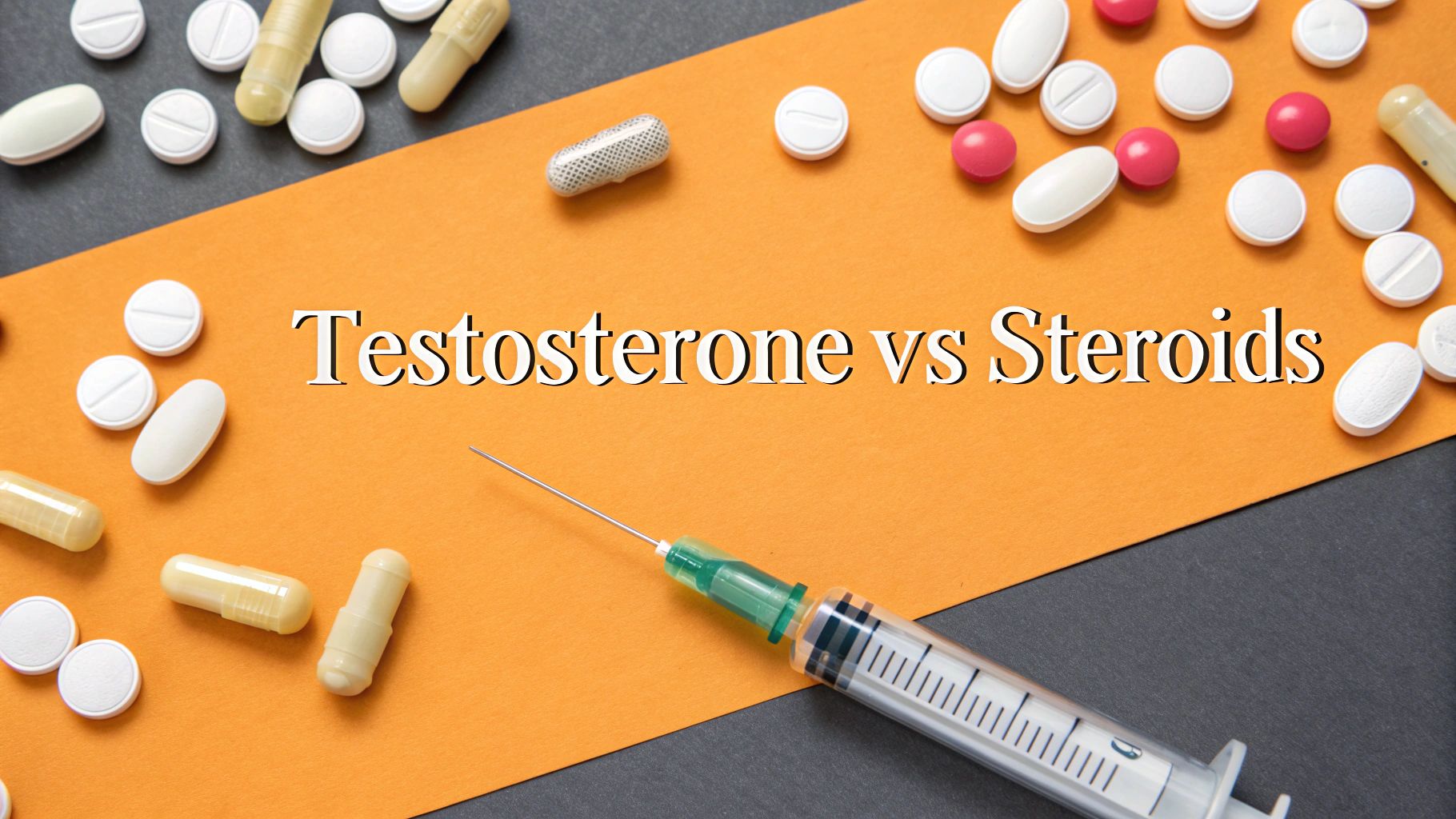Your Guide to Losing Weight on TRT

Lots of men jump into Testosterone Replacement Therapy thinking the fat is just going to melt off. The reality? TRT is a powerful catalyst, not a magic wand. It sets up the ideal hormonal stage, making sure the hard work you put into your diet and exercise actually pays off—and then some.
The Real Story Behind TRT and Weight Loss
When your testosterone levels are brought back into a healthy range, your body's entire operating system gets an upgrade. Think of it like finally getting a proper tune-up for your metabolic engine. With low testosterone, that engine is sputtering along, burning fuel inefficiently and storing the excess as fat, especially right around your gut. TRT gets that engine humming again.
This isn't just a nice idea; it's a documented physiological shift. Here’s what’s happening under the hood:
- A Hotter-Running Metabolism: Testosterone has a direct impact on your basal metabolic rate (BMR). As TRT helps you build more muscle, your body naturally burns more calories around the clock, even when you're just sitting on the couch.
- Smarter Fat Burning: It helps your body target and burn visceral fat—that’s the dangerous, deep-belly fat wrapped around your organs—while also preventing new fat from piling on.
- Easier Muscle Growth: TRT puts your body in a prime muscle-building state by boosting muscle protein synthesis. This is a game-changer because muscle is metabolically active tissue.
The bottom line is simple: TRT shifts your body into an anabolic state, where it’s geared to build lean muscle and torch fat. It makes every rep in the gym and every clean meal you eat count for more.
A Look at the Long-Term Payoff
These effects aren't just a flash in the pan. The long-term data shows a night-and-day difference between men who get on TRT and those who don't. For example, one huge 11-year study showed that obese men on TRT lost an average of 20.6% of their starting body weight and trimmed nearly 13 cm from their waistlines. The untreated group? They actually gained weight. For a deeper dive, you can explore the full findings of this long-term study on TRT and weight management to see the incredible impact for yourself.
The table below breaks down the study's findings, showing just how powerful consistent TRT can be over a decade compared to doing nothing.
TRT Weight Loss Potential Over 10 Years (Summary)
| Starting Weight Category | Average Weight Change with TRT | Average Weight Change without TRT |
|---|---|---|
| Normal Weight (BMI < 25) | -2.6% | +5.9% |
| Overweight (BMI 25-29.9) | -13.2% | +3.5% |
| Obese Class I (BMI 30-34.9) | -17.0% | +2.9% |
| Obese Class II/III (BMI ≥ 35) | -20.6% | +1.6% |
As the data clearly shows, TRT consistently led to significant, sustained weight loss across all weight classes, while the untreated men continued to gain weight over the same period.
This infographic gives you a quick visual of what you can expect when you pair TRT with a solid lifestyle plan.

It’s all about synergy. TRT creates the right hormonal environment, boosting your metabolism and ability to build lean mass, which in turn accelerates fat loss. This is the foundation that makes losing weight on TRT a very real and achievable goal when you back it up with the right strategies.
Navigating Initial Weight Gain on TRT

It’s one of the most common and frustrating experiences when starting TRT: you begin therapy to finally get leaner, but the first thing you notice is the number on the scale ticking up. This can feel incredibly discouraging, but it’s critical to understand what’s happening beneath the surface before you hit the panic button.
That initial gain is almost never a sign that you’re doing something wrong. In fact, it's usually the opposite. Your body is responding to restored hormone levels, and that early weight fluctuation is often a result of positive changes—namely, temporary fluid retention and, more importantly, the growth of new muscle.
Why the Scale Can Lie
Here’s a hard truth: when you’re building muscle, the scale becomes a terrible tool for tracking progress. Muscle is far denser than fat. A pound of muscle takes up significantly less space than a pound of fat, which means you can be actively getting leaner and trimming your waistline while your total body weight stays the same or even climbs a bit.
This is especially true in the first few months of TRT. At the same time, normalizing your testosterone can cause a temporary increase in water retention as your body adapts to the new hormonal environment. This water weight can easily add a few pounds, masking the real fat loss that’s just starting to ramp up. It’s a temporary phase that almost always resolves as your body finds its new balance.
The scale is a poor tool for measuring progress when you start TRT. Focus on how your clothes fit, your energy levels in the gym, and what you see in the mirror. These are far better indicators of successful body recomposition.
Finally, TRT often fires up your metabolism, and with it, your appetite. This is a double-edged sword. While a stronger appetite is a great sign of a faster-running metabolic engine, it can easily lead to overeating if you aren't paying attention.
The Real Reasons for Weight Changes
Testosterone therapy can paradoxically cause some initial weight gain, even though its primary long-term effect is torching fat and building lean mass. This happens due to a mix of physiological factors. TRT is well-known for increasing muscle mass, which is denser than fat, and it can also cause temporary water retention. On top of that, it can boost both your metabolism and your appetite, which might lead to a higher calorie intake if you don't manage it. To get a deeper dive, you can review the reasons for weight fluctuations during TRT.
The key is learning to distinguish between "good" weight (muscle) and "bad" weight (fat). Here’s how you do it:
- Take Measurements: Grab a tape measure and track your waist, hips, and chest. A shrinking waistline paired with a stable or increasing body weight is a classic sign you're losing fat and gaining muscle.
- Track Your Lifts: Are your numbers going up in the gym? Getting stronger is a direct, undeniable indicator of muscle growth.
- Use Progress Photos: A picture taken every four weeks gives you objective, visual proof of how your body composition is changing over time.
Ultimately, navigating that initial weight gain on TRT requires patience and a new perspective. Trust the process, celebrate the non-scale victories, and give your body the time it needs to adapt.
Building Your TRT-Optimized Nutrition Plan

Starting TRT gives your metabolism a serious upgrade, but it's no magic bullet. You can't just ignore what you eat and expect results. To really start shedding weight on TRT, you need a nutrition plan that works with your newly optimized hormones, not against them.
Think of it this way: your diet is the high-octane fuel your newly tuned engine needs to perform at its peak.
The first move is to look beyond generic calorie counting and get a real handle on your Total Daily Energy Expenditure (TDEE). As TRT helps you build more metabolically active muscle, your old TDEE calculation is basically useless. Your body is now burning more calories even at rest, so you need a new baseline to create a calorie deficit that's both effective and sustainable.
Prioritize Protein, Always
While all macronutrients play a role, protein becomes your single most valuable player when you're trying to lose weight on TRT. It’s the absolute cornerstone of preserving—and even building—muscle while you’re in a calorie deficit.
A solid target to aim for is 1.6 to 2.2 grams of protein per kilogram of body weight.
This high protein intake does three critical things for you:
- Preserves Muscle: It provides the essential building blocks to prevent your body from breaking down muscle tissue (catabolism) when calories are restricted.
- Boosts Satiety: Protein keeps you feeling fuller for longer, which is a huge help in managing the increased appetite that often comes with TRT.
- Increases Thermic Effect: Your body actually burns more calories just digesting protein compared to fats and carbs.
Don’t just hit your daily protein number—spread it out. Aiming for 30-40 grams of protein with each meal gives your muscles a steady supply of amino acids all day long. This maximizes the anabolic (muscle-building) benefits of your therapy.
Managing Your Revved-Up Appetite
It's common to feel ravenous once your metabolism kicks into high gear. Instead of fighting that hunger with pure willpower (which rarely works), you need to get strategic.
Focus on high-volume, nutrient-dense foods. We're talking leafy greens, cruciferous vegetables, lean proteins, and high-fiber fruits. These foods physically fill your stomach without overloading you on calories. A massive spinach salad topped with grilled chicken will keep you far more satisfied than a tiny, calorie-dense candy bar ever could.
And for those looking for an extra edge in their weight management journey, exploring complementary treatments can be a game-changer. Our guide on peptides for weight loss details options that can work alongside your TRT protocol to help control appetite and enhance fat loss.
Ultimately, your TRT-optimized nutrition plan isn’t about restriction; it’s about smart, strategic eating. Fuel your body with high-quality protein, outsmart your appetite with intelligent food choices, and maintain a moderate calorie deficit based on your new, improved metabolism. This is how you ensure you’re losing fat, not the hard-earned muscle that TRT helps you build.
Your Blueprint For Effective TRT Workouts

If TRT is the high-octane fuel for your body, then a smart exercise plan is the powerful engine that actually drives fat loss. Simply taking testosterone without a solid training regimen is like leaving a high-performance car parked in the garage. To truly succeed at losing weight on TRT, a dedicated workout program isn’t just a nice-to-have—it’s non-negotiable.
One of the biggest game-changers with TRT is the dramatic boost in recovery. With optimized testosterone levels, your body’s muscle protein synthesis—the process of repairing and rebuilding muscle—goes into overdrive. This means you can hit the gym with more intensity and frequency than before, bouncing back faster from tough sessions and seeing accelerated results.
The Foundation: Resistance Training
Resistance training is the absolute cornerstone of any effective workout plan on TRT. Lifting weights is how you build metabolically active muscle, which essentially turns your body into a 24/7 fat-burning furnace. The more muscle mass you carry, the higher your basal metabolic rate (BMR), meaning you burn more calories even when you're just sitting on the couch.
TRT amplifies the results of every single rep you perform, creating the perfect anabolic environment for muscle growth. This makes your gym time incredibly efficient. Your focus should be on big, compound movements that hit multiple muscle groups at once.
- Squats: The undisputed king of leg exercises, crucial for building lower body strength and mass.
- Deadlifts: A true full-body movement that develops your back, glutes, hamstrings, and core.
- Bench Press: The classic chest-builder that also lights up your shoulders and triceps.
- Overhead Press: Essential for building strong, broad shoulders.
- Rows: The perfect counterbalance to pressing movements, building a thick and powerful back.
For a deeper dive into structuring your lifts for maximum size and strength, check out our comprehensive guide on TRT and muscle gain. Understanding this synergy is the key to completely transforming your body composition.
Integrating Smart Cardio
While lifting builds the furnace, smart cardio is what stokes the fire. But here's the thing: not all cardio is created equal. Spending endless, mind-numbing hours on the treadmill can actually be counterproductive, potentially leading to muscle loss and burnout. The goal is to torch fat while preserving that precious muscle you're working so hard to build.
A much better approach is to mix different types of cardio:
- Low-Intensity Steady State (LISS): Think of a brisk walk on an incline treadmill for 30-45 minutes. This is perfect for active recovery days, as it burns fat without putting a ton of stress on your body.
- High-Intensity Interval Training (HIIT): This involves short bursts of all-out effort followed by brief recovery periods. A killer 15-20 minute HIIT session can be far more effective for torching calories and boosting your metabolism for hours after you've left the gym.
The synergistic effect of TRT and exercise is well-documented. TRT primes the body for change, but sustained physical activity is what secures long-term fat loss and lean mass retention.
This powerful relationship was perfectly illustrated in a case report where a man on TRT combined it with a structured workout program. He saw his total testosterone surge, which led to a significant increase in lean muscle and an impressive 3% drop in body fat in just six months. This shows that while the therapy sets the stage, your dedication in the gym is what delivers the final results. You can read more about these findings and the synergy between TRT and exercise.
How to Monitor and Optimize Your Protocol
Getting on TRT isn't a "set it and forget it" kind of deal, especially if your goal is long-term, successful weight loss. The real magic happens when you actively monitor how your body is responding and work with your doctor to fine-tune your protocol.
This ongoing management is what separates decent results from truly life-changing ones. It’s all about making small, smart adjustments based on real data.
The foundation of this entire process is regular blood work. While your Total Testosterone level gets all the headlines, it honestly doesn't tell you the whole story. To really understand what’s happening—and to make sure you’re actually losing fat—we need to look at the complete hormonal picture.
Key Blood Markers to Track
Think of your lab results as your personal roadmap. They show you what's going on under the hood, allowing you and your doctor to make informed decisions instead of just guessing.
Here are the critical markers you should be watching:
- Total and Free Testosterone: Total T is the overall amount of testosterone in your blood. But the real player here is Free T—that’s the unbound, biologically active testosterone your body can actually use. This number is often a much better indicator of how you feel and perform.
- Estradiol (E2): This is a key form of estrogen. Testosterone naturally converts into estradiol, and you need a healthy amount for your mood, joints, and libido. But if E2 creeps too high, it can cause water retention and make losing stubborn fat way more difficult.
- SHBG (Sex Hormone-Binding Globulin): This protein acts like a sponge, binding to testosterone and making it unavailable for your body to use. Tracking SHBG helps explain the relationship between your Total and Free T levels and why you might feel a certain way despite good "on paper" numbers.
Your TRT protocol is a dynamic system, not a static prescription. Your blood work provides the data you need to make small, intelligent tweaks to your dose or injection frequency, keeping you in that sweet spot for building muscle and torching fat.
Moving Beyond the Scale
While blood work gives you the internal picture, you need better tools than a simple bathroom scale to see what's happening on the outside. When you’re gaining muscle and losing fat at the same time—a common and fantastic outcome on TRT—your total body weight can be incredibly misleading. Don't let it fool you.
Instead, focus on these far more accurate methods to track your real progress:
- Body Measurements: Every four weeks, grab a flexible tape measure. Track the changes in your waist, hips, chest, and arms. A shrinking waistline is one of the clearest signs you're losing body fat, even if the scale hasn’t budged an ounce.
- Progress Photos: Once a month, take photos from the front, side, and back. Use the same lighting and pose each time. The visual changes you'll see over a few months will be undeniable and way more motivating than any number on a scale.
- How Your Clothes Fit: This is often the most satisfying indicator of all. When your pants start feeling looser around the waist while your shirts get a bit tighter across the shoulders and chest, you know you're succeeding at body recomposition. That's the win.
Monitoring your protocol is a crucial part of the investment in your health. If you're curious about the financial side, our article on the average cost of Testosterone Replacement Therapy gives a detailed breakdown of what to expect. This combination of diligent tracking and smart adjustments is the key to unlocking your best possible weight loss results on TRT.
Common Questions About Losing Weight on TRT
Getting started with TRT is a big step, and it's completely normal for a flood of questions to pop up as your body begins to change. When it comes to weight loss, the anwers aren't always what people expect. Let's walk through some of the most common things men ask, so you can move forward with confidence.
One of the first things on everyone's mind is the timeline. We all want to see results yesterday, but it's crucial to set realistic expectations right from the start.
How Quickly Will I Lose Weight on TRT?
While everyone’s body responds a bit differently, most guys start to see and feel tangible changes in their body composition within 3-6 months. This, of course, assumes you're pairing your therapy with a solid nutrition and exercise plan.
Here's something important to remember: the scale might not move much at first. Don't let that discourage you. This is often because you're building dense, lean muscle while shedding body fat—a process called body recomposition. Instead of obsessing over the number on the scale, pay attention to how your clothes are fitting, how much stronger you feel in the gym, and what you see in the mirror.
Significant, noticeable fat loss is more of a long game. The most dramatic visual changes often become clear after a year or two of consistent effort.
Can I Lose Muscle in a Calorie Deficit on TRT?
This is where TRT becomes a massive advantage. It's incredibly unlikely that you'll lose muscle while you're dieting. Testosterone is powerfully anti-catabolic, meaning it actively works to preserve your hard-earned muscle, even when you’re eating fewer calories to burn fat.
As long as you nail two key things, you can successfully drop fat while keeping—or even gaining—muscle:
- Prioritize Protein: Shoot for about 1.6 to 2.2 grams of protein per kilogram of your body weight. This gives your body the raw materials it needs to hold onto muscle.
- Keep Lifting Heavy: Your resistance training sessions are a powerful signal to your body that your muscle is essential and needs to be preserved.
This is a complete game-changer. Anyone who’s tried to diet with low testosterone knows the constant battle against muscle loss. With TRT, that battle is largely won for you.
Is High Estrogen Stopping My Weight Loss?
High estradiol (E2) can definitely complicate things, but it’s rarely the single reason your weight loss has stalled. When E2 levels climb too high, they can cause significant water retention. This makes you feel puffy and can easily mask the real fat loss that’s happening underneath, which is frustrating when you're looking at the scale.
It's critical to remember, however, that estradiol is absolutely vital for your libido, mood, and joint health.
Crashing your estrogen with aggressive use of aromatase inhibitors (AIs) is a classic mistake. It's often counterproductive and can leave you feeling absolutely awful. The goal is always balance, not total elimination.
If your blood work shows genuinely high E2 levels and you're feeling the symptoms, the first and best move is to talk to your doctor. They can discuss adjusting your TRT dose or injection frequency. This is a much safer and more sustainable strategy than jumping straight to an AI.
If I Stop TRT Will I Gain the Weight Back?
Unfortunately, the answer is almost certainly yes. When you stop TRT, your testosterone levels will fall back to their previous, hypogonadal state. This hormonal crash triggers a cascade of negative effects: your metabolism slows down, you begin to lose muscle mass, and your body's tendency to store fat returns with a vengeance.
The weight won't reappear overnight, but maintaining the lean, muscular physique you built on TRT is next to impossible without the therapy supporting it. This reality is a key reason why TRT is considered a lifelong commitment for men who have been diagnosed with clinical hypogonadism.
Ready to optimize your health and transform your body? The expert medical team at Elite Bioscience is here to guide you. We provide tailored TRT and peptide therapies to help you achieve your goals safely and effectively. Start your confidential health assessment today and discover what our personalized programs can do for you. Visit us at https://elitebioscience.co.
QUICK SEARCH
Make an account today to start your journey towards a better and healthier lifestyle.






